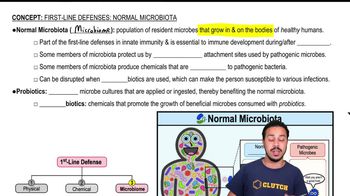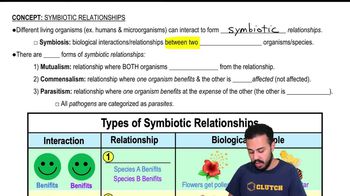Which one of the following diseases is not correctly matched to its reservoir?
a. influenza-animal
b. rabies-animal
c. botulism-nonliving
d. anthrax-nonliving
e. toxoplasmosis-cats
 Tortora 14th Edition
Tortora 14th Edition Ch. 14+15 - Principles of Disease and Epidemiology | Microbial Mechanisms of Pathogenicity
Ch. 14+15 - Principles of Disease and Epidemiology | Microbial Mechanisms of Pathogenicity Problem 14.7a
Problem 14.7a Verified step by step guidance
Verified step by step guidance



Which one of the following diseases is not correctly matched to its reservoir?
a. influenza-animal
b. rabies-animal
c. botulism-nonliving
d. anthrax-nonliving
e. toxoplasmosis-cats
How can a local infection become a systemic infection?
Use the following information to answer questions 6–7.
On September 6, a 6-year-old boy experienced fever, chills, and vomiting. On September 7, the child was hospitalized with diarrhea and swollen lymph nodes under both arms. On September 3, he had been scratched and bitten by a cat. The cat was found dead on September 5, and Y. pestis was isolated from the cat. Chloramphenicol was administered to the child from September 7, when Y. pestis was isolated from his blood. On September 17, the child's temperature returned to normal. On September 22, the child was released from the hospital.
Identify the incubation period for this case of bubonic plague.
a. September 3-5
b. September 3-6
c. September 6-7
d. September 6-17
Use the following information to answer questions 6–7.
On September 6, a 6-year-old boy experienced fever, chills, and vomiting. On September 7, the child was hospitalized with diarrhea and swollen lymph nodes under both arms. On September 3, he had been scratched and bitten by a cat. The cat was found dead on September 5, and Y. pestis was isolated from the cat. Chloramphenicol was administered to the child from September 7, when Y. pestis was isolated from his blood. On September 17, the child's temperature returned to normal. On September 22, the child was released from the hospital
Identify the prodromal period for this disease.
a. September 3-5
b. September 3-6
c. September 6-7
d. September 6-17
Put the following in the correct order to describe the pattern of disease: period of convalescence, prodromal period, period of decline, incubation period, period of illness.
Use the following information to answer questions 8–10.
A Maryland woman was hospitalized with dehydration. V. cholerae and Plesiomonas shigelloides were isolated from the patient, who had neither traveled outside the United States nor eaten raw shellfish during the preceding month. The patient had attended a party before hospitalization. Two other people at the party had acute diarrheal illness and elevated levels of serum antibodies against Vibrio. Everyone at the party ate crabs and rice pudding with coconut milk. Crabs left over from this party were served at a second party. One of the people at the second party had onset of mild diarrhea; specimens from of these people were negative for vibriocidal antibodies.
This is an example of
a. vehicle transmission.
b. airborne transmission.
c. transmission by fomites.
d. direct contact transmission.
e. healthcare-associated transmission.